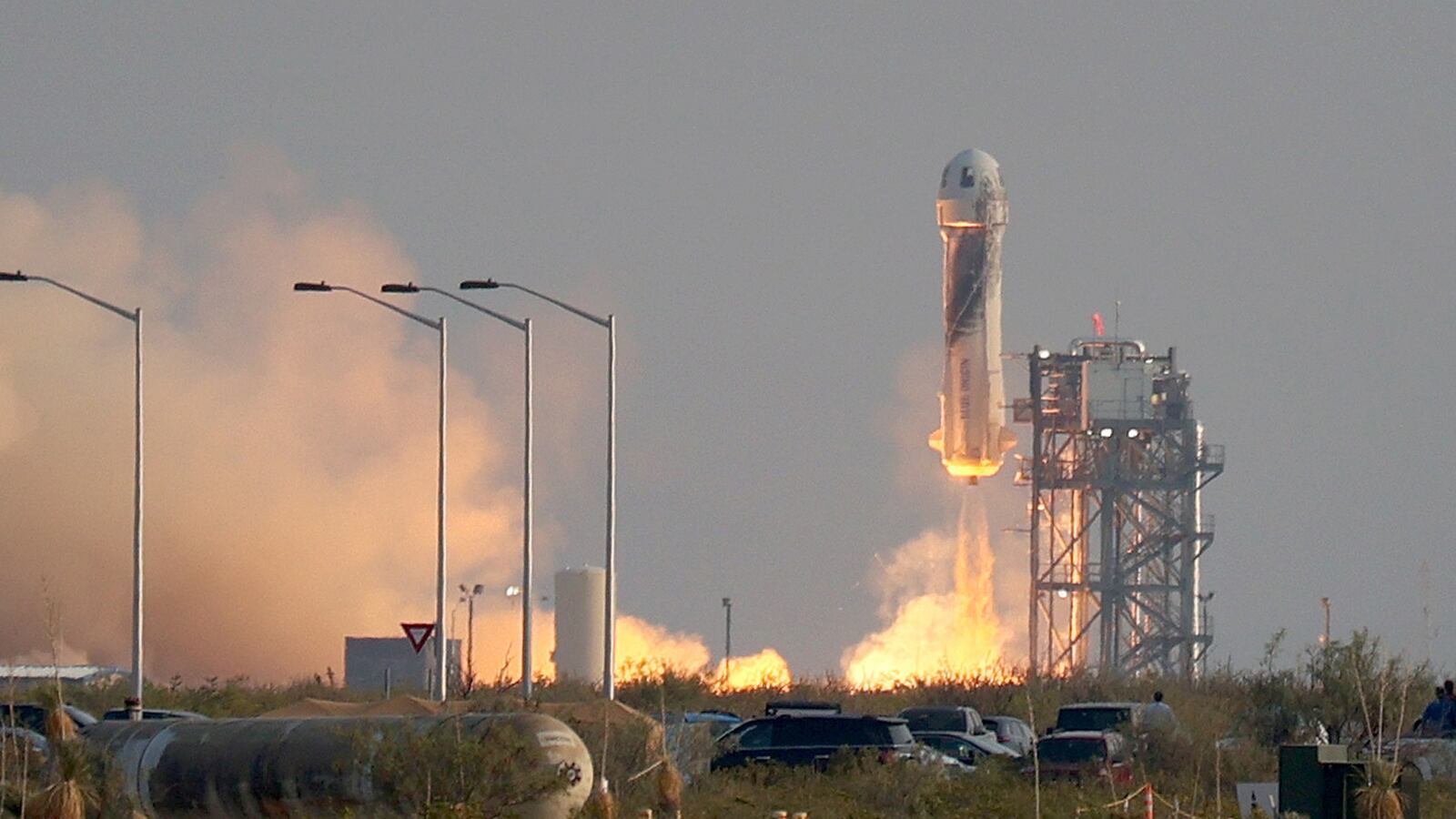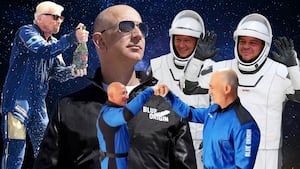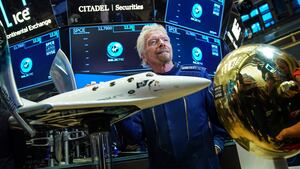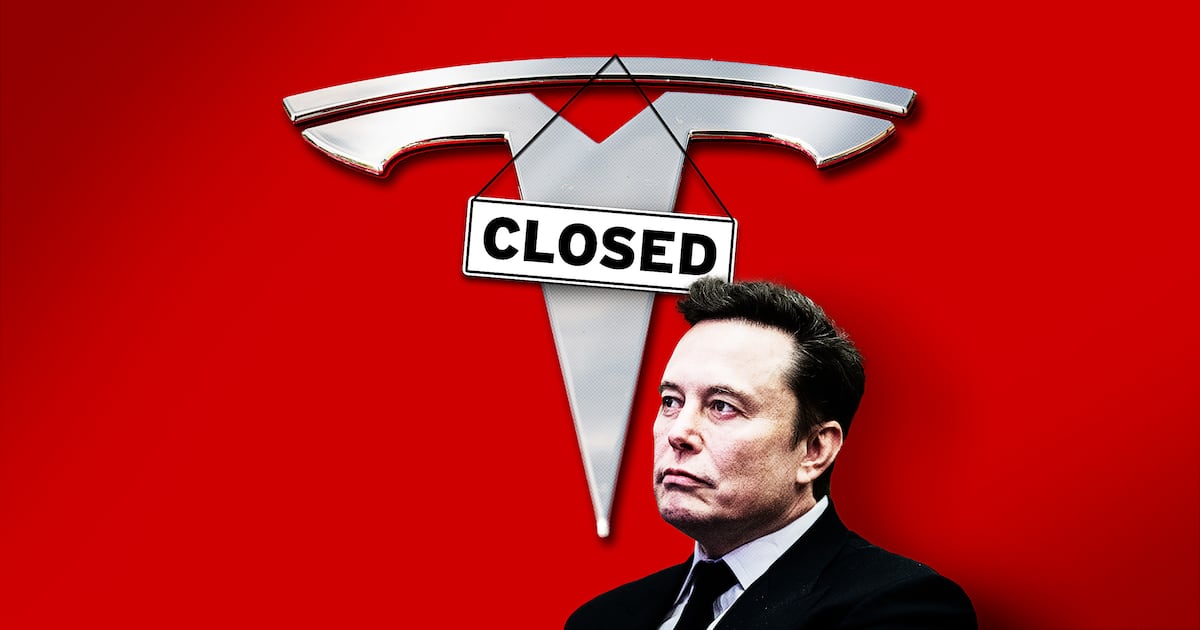OK, Jeff Bezos, yours is definitely bigger. A lot bigger.
It’s hard to imagine a more phallic instrument than the BlueOrigin rocket with its fully aroused glans bearing at its tip the capsule that finally ejaculated into space. Not to mention that roaring plume of fire at lift-off.
This was definitely more stimulating than watching Richard Branson’s initiation into suborbital ecstasy. With that we had to watch the long climb to launch height for 40 minutes, nearly half the flight, before his rocket ignited.
This time there was a marked difference in style: none of the emetic bio-babble lavished on Branson. Instead, it was all Prime delivery, cool, efficient, technical—and no ego-tripping.
The pre-launch hold was brief. The oddest sight was seeing through the giant windows the four passengers seated as though they were in a business class lounge, not sitting on top of a rocket.
With Bezos were his brother Mark, former female NASA astronaut Wally Funk who, at the age of 82, became the oldest person ever to go into space, and the youngest, 18-year-old Oliver Daemen, the only paying passenger, whose private equity mogul father bankrolled the ride after an unnamed person who made a winning bid of $28 million in a lottery for a seat dropped out at the last moment.
The 60-foot rocket lifted off from the remote base at Van Horn, in Texas, at just after 9:12 a.m. Eastern. Within minutes—to the audible whoops of the passengers—it crossed the Karman Line, the designated threshold of space at 62 miles above sea level. (Branson fell well short of that).
Meanwhile, the booster rocket was heading back to the pad to be ready for another trip. The New Shepard capsule, named for Alan Shepard, the first American in space, descending on parachutes, plopped gently on the baking west Texas tundra where the four passengers had to wait for the hatch to be opened. After just 11 minutes, that was it.
Bezos and Branson are basically both selling the same thrill—rocket ride, few minutes of weightlessness, gobsmacking views—but in very different packages.
Galactic has the tedious air launch, but it also has the more elegant finish, gliding to a runway landing. On the other hand, if something goes wrong there is no way for passengers to eject to safety. The entire Blue Origin system, meanwhile, is based on the original NASA device to hurtle astronauts clear of an exploding rocket and descend safely on parachutes. That has been successfully tested.
The problem is that when all the ballyhoo dies down, after all the champagne corks have popped, it will become clear that “space tourism” is one of those ideas that gets overtaken by events.
In 2004, when he launched Virgin Galactic, Branson struck a messianic tone: “It will be humbling. It will be spiritual.” Bezos was even more expansive when he became a space missionary in 2000. He introduced Blue Origin as part of a personal mission to “create a future where millions of people are living and working in space to benefit Earth.”
Both of them were giving an evocative spiritual spin to what was, essentially, an extravagant indulgence that only very few would ever get to experience.
Unfortunately for them, it’s become much harder now to give credence to those lofty mission statements. They represent a time that has already passed, dispatched with urgency.
Our dwelling space has changed dramatically. The planet’s ability to support human life is under enormous new pressures from the confluence of a pandemic and an acceleration of extreme weather events that have shaken even the most ardent believers in climate change.
One of the complaints being heard is about the environmental impact of these flights. For example, the Financial Times calculated that the carbon emissions per passenger per mile for Galactic were nearly 12 times those for a business class round-trip across the pond on Virgin Atlantic. But the Galactic flights are so infrequent that the comparison really doesn’t have a point.
The larger and most consequential complaint about suborbital joyrides is their sheer social incongruity. It just seems obscene that all this technical effort is devoted to what is really the world’s most expensive theme park ride. This isn’t “the New Space Age.” It’s a pastiche of the original Space Age without its soaring reach of purpose—to get to the moon and survey the deep mystery of the planets.
Before the Blue Origin launch, there was the familiar theme that these flights are a “life-changing” moment for the passengers as they get to see the beauty (and presumably fragility) of the planet. No doubt true—but it’s a luxury that is counter-productive. Just doing it becomes part of the problem, not an understanding of it.
Branson attempted to address the critics when he appeared on the Stephen Colbert show. Colbert has emerged as his favorite shill and immediately handed Branson an escape route. He set up a false equivalence by including the Galactic jaunt with the whole of space exploration—if you were against one you were against the other. Branson took the opening, claiming that without the space program there would be no television, presumably meaning no satellite television, and then displayed amazing condescension by saying that his critics were “not fully educated.”
Bezos, a day before he flew, seemed to be a lot more careful about his mission statement. He said it “will allow us to build the infrastructure to let the next generations of people really do amazing things in space.”
In his case, it’s partly true, but disingenuous. The suborbital parts of Blue Origin’s business are a minor sideline, a plaything for Bezos. He’s made a huge investment in developing New Glenn, a huge booster rocket for launching satellites and he’s bidding for ambitious NASA contracts with the same seriousness of intent that built Amazon in the first place. But the New Shepard capsule leads nowhere. In evolutionary terms, it’s already a museum piece.
Alongside Bezos’ bottomless pockets, Branson is a pauper billionaire. He hoped his flight would help boost new rounds of fundraising needed to give his business a credible future. But when he issued new stock to fund development, the price slumped, at one point cutting a billion dollars from the company’s worth.
In August 2011, when Branson was making wildly optimistic predictions for Galactic’s first flight, NASA launched its Juno mission to survey Jupiter. The solar-powered probe arrived there in July 2016. In the last month, we’ve been getting some sensational close-ups from a fly-by of Jupiter’s 3,273-mile-wide moon, Ganymede, the largest in the solar system. It took Juno 14 hours and 50 minutes to travel the 735,000 miles between Jupiter and Ganymede.
You can take a compact version of the trip on NASA’s website and it’s truly awesome as you fly 2,100 miles above Jupiter’s massive cloud tops. Scott Bolton, one of the scientists involved, said, “The animation shows just how beautiful space exploration can be.” Indeed. A few minutes of that and you know the difference between frivolous toys and revelatory human endeavor. And this costs you nothing.









